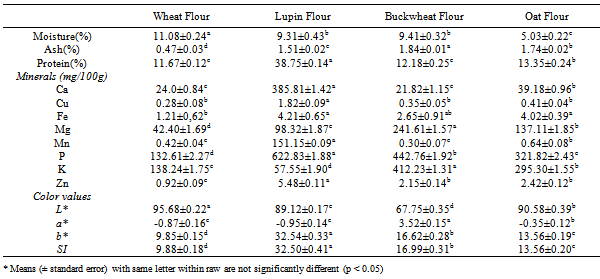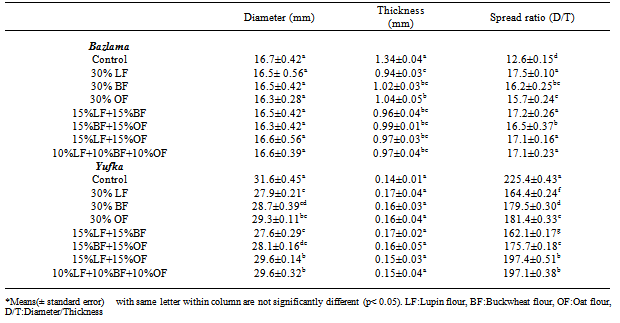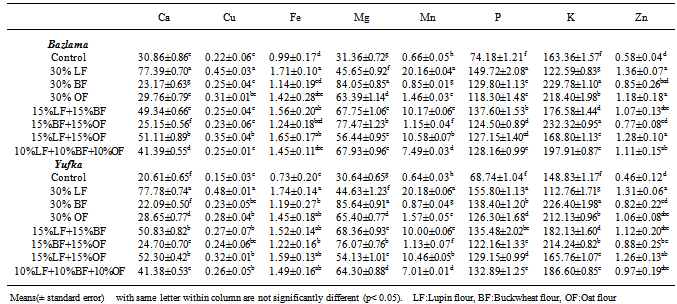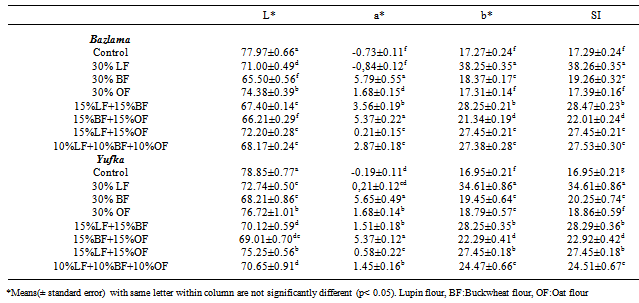-
Paper Information
- Next Paper
- Previous Paper
- Paper Submission
-
Journal Information
- About This Journal
- Editorial Board
- Current Issue
- Archive
- Author Guidelines
- Contact Us
International Journal of Food Science and Nutrition Engineering
p-ISSN: 2166-5168 e-ISSN: 2166-5192
2012; 2(5): 89-95
doi: 10.5923/j.food.20120205.04
Evaluation of Physical, Chemical and Sensory Properties of Turkish Flat Breads (Bazlama and Yufka) Supplemented with Lupin, Buckwheat and Oat Flours
Hacer Levent 1, Nermin Bilgiçli 2
1Mut Vocational School for Higher Education, Mersin University, Mersin, 33600, Turkey
2Department of Food Engineering, Agricultural Faculty, Selçuk University, Konya, 42049, Turkey
Correspondence to: Hacer Levent , Mut Vocational School for Higher Education, Mersin University, Mersin, 33600, Turkey.
| Email: |  |
Copyright © 2012 Scientific & Academic Publishing. All Rights Reserved.
In this research, lupin, buckwheat and oat flours (30%) and their blends (15%+15% and 10%+10%+10%) were used in Turkish flat breads (bazlama and yufka) production for nutritional enrichment. Some physical (diameter, thickness, spread ratio and color), chemical (moisture, ash, crude protein and mineral content) and sensory properties of bread samples were investigated. High protein levels of lupin flour (LF) increased the protein content of bazlama and yufka samples from 11.85% and 11.62 % to 19.97% and 19.74 %, respectively. The highest ash content was obtained with addition of 30% buckwheat flour (BF) in flat breads. Generally all of the minerals in breads containing LF, BF and oat flour (OF) or their blends were found significantly higher (p<0.05) than that of control breads. BF addition increased the darkness and redness of the bread samples. While the lowest sensorial scores for flat breads were obtained with 30% LF or 15% LF+15% OF addition, bazlama containing 30% OF or 10% LF+10% BF+10% OF and yufka containing 30% OF or 15% LF+15% BF or 10% LF+10% BF+10% OF appreciated with higher rates after control breads by panelists. Considering physical, chemical and sensory properties of flat breads, it can be concluded that LF, BF and OF can be used at 10% LF+10% BF+10% OF levels successfully for both bazlama and yufka production.
Keywords: Lupin, Buckwheat, Oat, Bazlama, Yufka
Cite this paper: Hacer Levent , Nermin Bilgiçli , "Evaluation of Physical, Chemical and Sensory Properties of Turkish Flat Breads (Bazlama and Yufka) Supplemented with Lupin, Buckwheat and Oat Flours", International Journal of Food Science and Nutrition Engineering, Vol. 2 No. 5, 2012, pp. 89-95. doi: 10.5923/j.food.20120205.04.
Article Outline
1. Introduction
- Bread has a great importance in human nutrition as a protein and carbohydrate source. In Turkey, cereal based products especially bread has great importance in diets, 66%of the energy consumed per capita is supplied from cereals and 56% of this energy is supplied only from breads [1]. There are so many flat bread types all over the world known with different names such as chapatti, tortilla, tandoori, pita, baladi, taboon, lavash etc.[2]. Bazlama and yufka are the traditional flat bread types of Turkey. Bazlama is single layered, leavened, circular flat bread with creamy yellow color. It has average 3 cm thickness and diameters ranging from 10 to 20 cm[3]. Yufka is single layered but unleavened bread with 1-2 mm thickness, 40-50 cm diameters and cream-color surface [4],[5] . Lupin (Lupinus albus spp) as a valuable ancient legume contains comparatively higher amount of protein (about 40%by weight) than cereals and other legumes except soy. Lysine content of lupin proteins is high whereas methionine content is low. When LF and wheat flour used together in food formulations, complementary effect is achieved due to the low lysine and high sulphur-containing amino acids (methionine and cysteine) content of wheat flour proteins [6]. Lupin is also rich in dietary fiber (30–40%), fat (6-13%), phytochemicals including antioxidants and phytosterols, vitamin and minerals [7-11].Buckwheat (Fagopyrum esculentum Moench) is nutritious pseudocereal with its high biological value protein, dietary fiber, vitamins B1, B2 and E [12],[13]. It is also a good source of essential minerals (Fe, Mn, Zn and Se), phytochemicals (especially rutin and quercetin) [13],[14]. It has anti- inflammatory and anticarcinogenic effects, controls the blood vessels and prevents haemorrhagic diseases and edema, reduces high blood pressure [15],[16],[17].Oat is known with its high β-glucans content (2.2-7.8%) which is soluble dietary fibre [18], B complex vitamins, protein, fat and minerals [19]. Cereal β-glukan usage, increase the functional quality of foods. It reduces the blood glucose, cholesterol and triglyceride level. It also protect humans against colon cancer [20],[21]. Considering nutritional and functional properties, lupin, buckwheat and oat flour has a high potential to be used in different foods.In the literature, it has been reported that Turkish flat bread types enriched by barley flour and wheat bran [3],[4], triticale flour [22], resistant starch [5] and dairy by-products [23]. Due to the being of basic food in our diet, it is aimed to increase the nutritional and functional quality of flat breads by the incorporation of LF, BF and OF.
2. Materials and Methods
2.1. Materials
- Buckwheat groats (without hull) were obtained from Yar Gıda, Antalya, Turkey. Lupin (Lupinus albus L.) seeds were purchased from local market as traditionally debittered. Wheat flour, salt, sugar, fresh yeast and oat were purchased from local markets in Konya. Buckwheat, lupin seeds (after drying at 60℃ for 24 hr) and oat were ground in a hammer mill (Falling Number-3100 Laboratory Mill; Perten Instruments AB, Huddinge, Sweden) to obtain wholegrain flour.
2.2. Methods
2.2.1. Bazlama and Yufka Preparation
- Flat bread samples were prepared according to Akbaş [24], Başman and Köksel [4] respectively by using the formulations in Table 1. LF, BF and OF were replaced with wheat flour at 30%, 15%+15% and 10%+10%+10% levels in both bazlama and yufka samples. All the ingredients were mixed in a Hobart mixer (Hobart N50, Canada Instruments, North York, Ontario, Canada) for optimum dough development. For bazlama preparing, doughs were fermented for 1 hour at 30℃ and divided into two equal pieces and shaped with hand like a ball and allowed to rest for 6 minutes at room conditions. After that, doughs were sheeted to final thickness of 10 mm by using stainless steel circle of 17 cm diameter and baked at 280 ± 5℃ on preheated sac for 5 minutes (1500 W). For yufka samples, after mixing, doughs were allowed to rest at 30℃ for half an hour and divided into four equal pieces, shaped like a ball, sheeted by hand rolling to the 1 mm thickness with the aid of their own flour. After sheeting, it was baked on preheated sac 280 ± 5℃ for 1 min.Baked bazlama and yufka samples were cooled at room temperature for 1 hour and after physical measurements and sensory evaluation, samples were stored in plastic bags for chemical analyses.The color of flours and bread samples was evaluated by measuring the L*, a* and b* values using a Minolta CR-400 (Konica Minolta Sensing, Inc., Osaka, Japan). Saturation index (SI) ((a*2 + b*2)1/2) of the samples were calculated.
2.2.2. Chemical Analyses
- The samples were analyzed for their moisture, ash, crude protein using AACC standard methods [25].The mineral (Ca, Cu, Fe, Mg, Mn, P, K and Zn) contents of the samples were determined by an Inductive coupled plasma atomic emission spectrometry (ICP-AES) (Vista series, Varian International AG, Zug, Switzerland) as given by Bubert and Hagenah [26].
2.2.3. Sensory Analyses
- Bazlama and yufka samples were evaluated by 12 panelist who are familiar to flat breads. The sensory quality characteristics of bazlama (appearance, shape and symmetry, texture, mouthfeel, taste and odor, overall acceptability) and yufka samples (appearance, elasticity, mouthfeel, taste and odor, overall acceptability) were evaluated on a 1-9 scale where 1 represented “dislike extremely”, 4-5 represented “acceptable” and 8-9 represented “like extremely”.
2.2.4. Statistical Analyses
- All data were subjected to analysis of variance (ANOVA) and Student’s t comparison test. Statistical analyses were performed using the Statistical software JMP 5.0.1 (SAS Institute).
3. Results and Discussion
3.1. Raw Material Properties
- The analyses results of flours used in the production of bazlama and yufka are presented in Table 2. The ash content of BF was significantly higher (p<0.05) than that of other flours. LF had higher protein and mineral content (especially Ca, Cu, Fe, Mn, P and Zn) according to BF and OF. Also, BF was found to be a good source for Mg and K minerals. Literature knowledge confirmed our ash, protein and mineral analyses for different flours [6],[27],[28],[29]. As expected, BF gave the lowest L*(lightness) and the highest a*(redness) values. The highest b* (yellowness) value was obtained with LF due to the natural seed characteristics. It is reported by Doxastakis et al. [27] that the yellow colors of the LF have a considerable appeal and would be a value in many foods.
3.2. Pyhsical Properties of Bazlama and Yufka
- The diameter, thickness and spread ratio of flat breads are summarized in Table 3. The usage of LF, BF and OF or their blends did not significantly (p>0.05) affected the diameters of bazlama samples, but decreased thickness and increased spread ratio. The lowest thickness and highest spread ratio values were obtained with LF supplemented bazlama samples.Yıldız [30] reported that BF usage (0-30 %) in bazlama formulations did not significantly affected the diameter and thickness of the samples. In present study, usage of LF, BF and OF or their blends decreased the diameter and spread ratio of yufka samples. While 15% LF+15% OF and 10% LF+10% BF+10% OF gave higher diameter and spread ratio after control samples, 15%LF+15%BF caused the highest decrement in these parameters in yufka samples.
|
|
|
3.3.Chemical Compositions of Bazlama and Yufka
- Chemical compositions of flat bread samples are given in Table 4. The moisture content of bazlama and yufka samples with 15% BF+ % 15 OF and 15% LF+15% OF were not found significantly different (p>0.05) compared to control. The usage of BF at 30% level increased the ash content of bazlama and yufka samples from 1.25% and 1.20% to 1.71% and 1.65%, respectively. In the literature, it is reported that the ash content of spaghetti and tarhana increased with the addition of BF due to the rich ash content of BF [6],[29]. Protein contents of bazlama and yufka samples were found between 11.85% and 19.97%; 11.62% and 19.74%, respectively. The highest protein value was obtained with the addition of LF in both bazlama and yufka samples. Jayasena et al. [31] reported that there was 42% increment in protein content of instant noodles by replacing only 20% wheat flour with LF. Also Ballester et al. [32] found the increment in protein content of the cookies up to 55.7% with LF (5-25%) addition.
3.4. Mineral Compositions of Bazlama and Yufka
- Mineral contents of bazlama and yufka samples are given in Table 5. The rich mineral content of LF, BF and OF caused to increase in mineral content of flat breads. The increments in bazlama and yufka samples with 30% LF supplementation were found as 2.5 and 3.77 times in Ca, 2.0 and 3.2 times in Cu, 1.73 and 2.38 times in Fe, 30.5 and 31.5 times in Mn, 2.0 and 2.27 times in P, 2.34 and 2.84 times in Zn according to control samples respectively. BF addition (at 30% level) increased the Mg and P contents (mg/100g) of bazlama and yufka samples from 31.36 and 30.64 to 84.05 and 85.64, respectively.It is reported that the lupin enriched pasta samples showed higher amounts of protein, Ca, P, Mg and Zn content than control pasta [33]. Bilgiçli [29] found increments in the mineral contents (especially K, Mg and P) of tarhana samples with the addition of BF. In the study conducted by Tamime et al. [34] Mn, P and Mg content of Kishk samples made from oat varieties were found higher than that of barley and wheat. In another study, it is reported that K, Ca and Fe contents of couscous prepared with oat flour were higher than that of traditional couscous and couscous with eggs [35].
3.5. Color values of bazlama and yufka
- Color values of samples are presented in Table 6. Raw material colors directly affected the color of flat breads. The lowest L* values were observed in 30% BF and 15% BF+15% OF bazlama and yufka samples. Bilgiçli [29] and Lin et al. [36] reported that BF enriched tarhana and bread had lower L and higher a and b values than that of control products. The natural dark pigmentation of whole BF and the tendency of BF on Maillard reaction could be effective on this color change [37]. The usage of LF increased the b*(yellowness) values of bazlama and yufka samples at all addition levels. Similarly, it was reported that the crumb colors of breads prepared with LF became more yellowish [27]. Generally b* and SI values showed same tendency, the highest SI values were found in LF at 30% levels.
3.6. Sensory Properties of Bazlama and Yufka Samples
- The sensory scores of bazlama and yufka samples are presented in Table 7 and 8. Enriched bazlama samples prepared with the addition of OF at 30% level and blends of LF, BF and OF at equal ratios (10%) were scored higher for their appearance, shape and symmetry, texture, taste and odor after control bread. Yufka samples produced with 30% OF or 15% LF+ 15% BF or the blends of LF, BF and OF at equal ratios (10%) gave high overall acceptability scores. Supplementation of breads with 30% LF or 15% LF + 15% OF gave the lowest sensory attributes in flat breads. The highest decrement on taste and odor scores of bazlama and yufka samples was found at 15%LF +15%OF and 30% BF addition respectively.
|
|
|
|
|
4. Conclusions
- In the present study, bazlama and yufka (Turkish flat breads) enriched with LF, BF, OF and the effects of these flours on the physical, chemical and sensory properties of breads were investigated. The rich composition of LF, BF and OF improved the nutritional quality of bazlama and yufka samples in terms of ash, protein and mineral content (Ca, Cu, Fe, Mg, Mn, P, K, Zn). The yellow color of LF and dark color of BF directly affected the surface color of bazlama and yufka. It can be concluded from the results of this study that acceptable bazlama and yufka can be produced by the addition of the LF, BF and OF at equal ratio (10%).
 Abstract
Abstract Reference
Reference Full-Text PDF
Full-Text PDF Full-Text HTML
Full-Text HTML






